
Erasmus of Lueg [1] (German : Erasmus von Lueg, [2] [3] Erasmus Lueger; Slovene : Erazem Predjamski [4] ) was a burgrave of Predjama Castle in the 15th century and a renowned robber baron. [4]

Erasmus of Lueg [1] (German : Erasmus von Lueg, [2] [3] Erasmus Lueger; Slovene : Erazem Predjamski [4] ) was a burgrave of Predjama Castle in the 15th century and a renowned robber baron. [4]
He was the son of the Imperial Governor of Trieste, Nikolaj Lueger.
According to legend, in 1483 he killed Marshall Pappenheim at the Vienna Court [2] during an argument in which Pappenheim had offended the honor of Erasmus's dead friend, Andreas Baumkircher of Vipava. However, Pappenheim was a relative of Holy Roman Emperor Frederick III so Erasmus fled to his castle, Predjama, to escape punishment. [4] He then allied himself with the Hungarian King Matthias Corvinus and started to attack Habsburg estates and towns in Carniola. [2] Emperor Fredrick III sent the governor of Trieste, Gaspar Ravbar, to besiege Predjama Castle. Ravbar tried to starve Erasmus to death, but Erasmus survived on food delivered via a secret tunnel through the cave system under the castle.
Erasmus was killed after a long siege. [4] According to a popular but unfounded legend, Erasmus was betrayed by one of his men and was killed while in his room, or in his garderobe, by a shot from a cannon or catapult. [5] [6]

The House of Habsburg, also known as the House of Austria, was one of the most prominent and important dynasties in European history.

Magnus Maximus was Roman emperor in the West from 383 to 388. He usurped the throne from emperor Gratian.

Trieste is a city and seaport in northeastern Italy. It is the capital and largest city of the autonomous region of Friuli-Venezia Giulia, as well as of the regional decentralization entity of Trieste.

Princess Katharina of Württemberg was Queen of Westphalia by marriage to Jérôme Bonaparte, who reigned as King of Westphalia between 1807 and 1813.
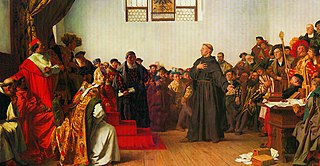
The Diet of Worms of 1521 was an imperial diet of the Holy Roman Empire called by Emperor Charles V and conducted in the Imperial Free City of Worms. Martin Luther was summoned to the diet in order to renounce or reaffirm his views in response to a Papal bull of Pope Leo X. In answer to questioning, he defended these views and refused to recant them. At the end of the diet, the Emperor issued the Edict of Worms, a decree which condemned Luther as "a notorious heretic" and banned citizens of the Empire from propagating his ideas. Although the Protestant Reformation is usually considered to have begun in 1517, the edict signals the first overt schism.

Miramare Castle is a 19th-century castle direct on the Gulf of Trieste between Barcola and Grignano in Trieste, northeastern Italy. It was built from 1856 to 1860 for Austrian Archduke Ferdinand Maximilian and his wife, Charlotte of Belgium, later Emperor Maximilian I of Mexico and Empress Carlota of Mexico, based on a design by Carl Junker.

Erasmus of Formia, also known as Saint Elmo, was a Christian saint and martyr. He is venerated as the patron saint of sailors and abdominal pain. Erasmus or Elmo is also one of the Fourteen Holy Helpers, saintly figures of Christian religion who are venerated especially as intercessors.

Pappenheim was a German county in western Bavaria, Germany, located on the Altmühl river between Treuchtlingen and Solnhofen, and south of Weißenburg. As former sovereign family, mediatized to Bavaria in 1806, the family which ruled the state belongs to High nobility.

Michael I Komnenos Doukas, Latinized as Comnenus Ducas, and in modern sources often recorded as Michael I Angelos, a name he never used, was the founder and first ruler of the Despotate of Epirus from c. 1205 until his assassination in 1214/15.

Johann Philipp, Graf von Cobenzl was a statesman of the Habsburg monarchy and the Austrian Empire.
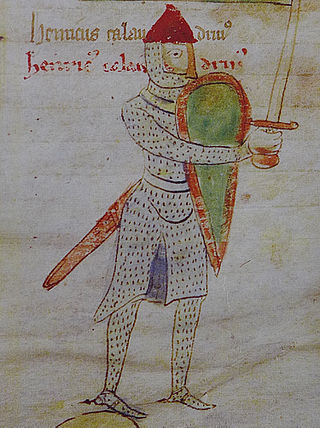
Henry of Kalden was a ministerialis in the service of the German kings Henry VI, Philip, Otto IV, and Frederick II.

Prince Karl Emich of Leiningen, also known by his Orthodox Russian name Nikolai Kirillovich Romanov, and recognized with the regnal name Emperor Nicholas III by Monarchist Party supporters of the Imperial Throne, is the eldest son of Emich, 7th Prince of Leiningen and his wife, Duchess Eilika of the Grand Duchy of Oldenburg, and is an elder brother of Andreas, 8th Prince of Leiningen.

Ljubljana Castle is a castle complex standing on Castle Hill above downtown Ljubljana, the capital of Slovenia. It is a key landmark of the town. Originally a medieval fortress, it was probably constructed in the 11th century and rebuilt in the 12th century. It acquired its present outline with an almost complete overhaul in the 15th century, whereas the majority of the buildings date to the 16th and 17th centuries. Initially a defense structure and since the first half of the 14th century the seat of the lords of Carniola, it was since the early 19th century used for various other purposes and today is used as a major cultural venue.
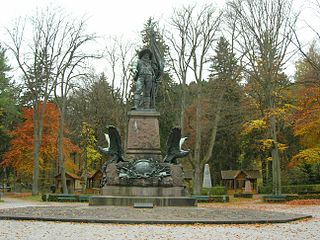
The Battles of Bergisel were four battles fought between Tyrolese civilian militiamen and a contingent of Austrian government troops and the military forces of Emperor Napoleon I of France and King of Kingdom of Bavaria against at the Bergisel hill near Innsbruck. The battles, which occurred on 25 May, 29 May, 13 August, and 1 November 1809, were part of the Tyrolean Rebellion and the War of the Fifth Coalition.

Predjama Castle is a Renaissance castle built within a cave mouth in south-central Slovenia, in the historical region of Inner Carniola. It is located in the village of Predjama, approximately 11 kilometres from the town of Postojna and 9 kilometres from Postojna Cave.

Brežice Castle is a 16th-century castle in the town of Brežice, in southeastern Slovenia, at the street address Cesta prvih borcev 1.

Overlord: Dark Legend is an action role-playing game developed by Climax Action and published by Codemasters for the Wii. The game was released on 23 June 2009 in North America, 26 June in Europe, and 3 July in Australia.
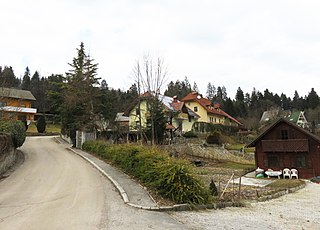
Kolovec is a settlement northeast of Domžale in the Upper Carniola region of Slovenia.

Lož Castle, also known as Pusti Grad, is a castle ruin above the settlement of Lož in central Slovenia's Lož Valley. The castle and its lordship are mentioned in period documents under various names, including Los, Louse, Lose, and Lösch.
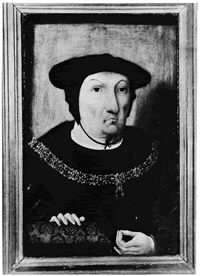
John III, Lord of Bergen op Zoom or John III of Glymes was a noble from the Low Countries.